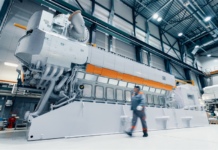
The Chinese government has called US President Joe Biden’s allegation of espionage, using made-in-China container handling cranes, as pure conjecture.
Biden signed an executive order on 21 February, prohibiting US container terminals from using Chinese-made ship-to-shore cranes.
A White House statement said: “This action is a vital step to securing our maritime infrastructure’s digital ecosystem and addresses several vulnerabilities that have been identified in the updated US Maritime Advisory, 2024-00X – Worldwide Foreign Adversarial Technological, Physical, and Cyber Influence, that was released today (21 February).”
In response, Liu Pengyu, spokesperson for the Chinese embassy in the US, said: “The claim that Chinese-made cranes pose a national security risk to the US is pure conjecture and China firmly opposes the US government’s generalisation of the concept of national security and the abuse of state power to obstruct normal economic and trade cooperation between China and the US.”
The banning of Chinese-made-ship container cranes appears to have given momentum to Biden’s Investing in America campaign to rebuild the US economy, as the US president has ordered these cranes be replaced with made-in-US cranes operating on Japanese technology.
Substituting all the China-made cranes will be a massive undertaking as Chinese machinery manufacturer Shanghai Zhenhua Heavy Industries (commonly branded as ZPMC) has an 80% market share in US ports.
Over the next five years, the Biden administration will invest over US$20 billion in US port infrastructure, and consequently, PACECO Corp., a US-based subsidiary of Japanese machinery maker Mitsui E&S will manufacture container cranes in the US.
PACECO has a deep history in the container shipping industry, manufacturing the first dedicated ship-to-shore container crane in 1958 as PACECO Inc., and it continued US-based crane manufacturing until the late 1980s. PACECO intends to partner with other trusted manufacturers to bring port crane manufacturing capabilities back to the US for the first time in 30 years, pending final site and partner selection.
This action also ties in with the White House Council on Supply Chain Resilience’s efforts to strengthen US supply chains, particularly by addressing supply chain risks resulting from threats and vulnerabilities inside the country’s ports.
Martina Li
Asia Correspondent





